How a solar charge controller works?
Although the control circuit of the controller varies in complexity depending on the PV system, the basic principle is the same. The diagram below shows the working principle of the most basic solar charge and discharge controller.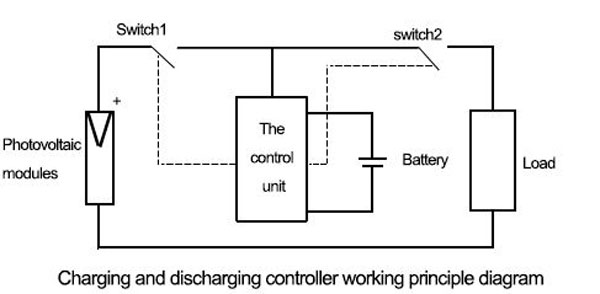
Although the control circuit of the controller varies in complexity depending on the PV system, the basic principle is the same. The diagram below shows the working principle of the most basic solar charge and discharge controller.
The system consists of PV module, battery, controller circuit and load. Switch 1 and Switch 2 are the charging switch and the discharging switch, respectively. When switch 1 is closed, the battery is charged by the PV module, and switch 1 also automatically resumes charging the battery according to a pre-set protection mode. When switch 2 is closed, the battery supplies power to the load. When the battery is charged again and reaches the pre-set resuming charging point, switch 2 can automatically resume power supply again.
Types of solar charge controllers
According to the controller on the battery charging regulation principle, the commonly used charge controller can be divided into.
1. Series type charge controller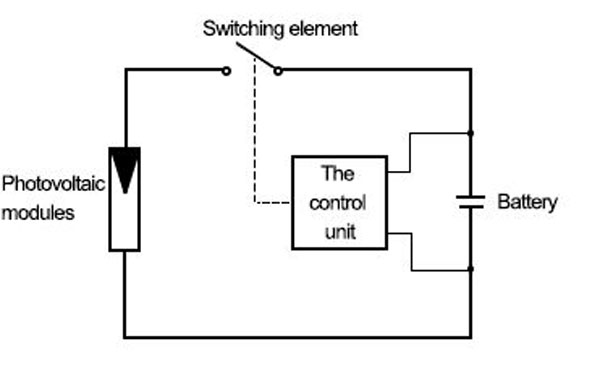
The series controller circuit principle is shown in the figure, with a switching element connected in series between the PV module and the battery. The control detector circuit monitors the battery terminal voltage and when the charging voltage exceeds the battery set full disconnect value (HVD), the switching element cuts the battery charging circuit and resumes battery charging.
Series charge controllers can use relays as fast shutoffs, currently most use power field effect tubes (MOSFETs), IGBTs, solid state relays, etc. Perfectly designed series charge controllers also have switching elements that can replace anti-reverse diodes to prevent "reverse leakage" at night.
Series charge controllers have a large voltage loss in the circuit because the control switch elements are connected in series in the charging circuit, which reduces the charging efficiency, and when the switch elements are disconnected, the input voltage will rise to the level of the open circuit voltage of the power generation unit. Therefore, the series type charge controller should be designed with MOSFETs of low pass-state internal resistance and IGBTs of low saturation voltage drop.
2. Parallel charge controller
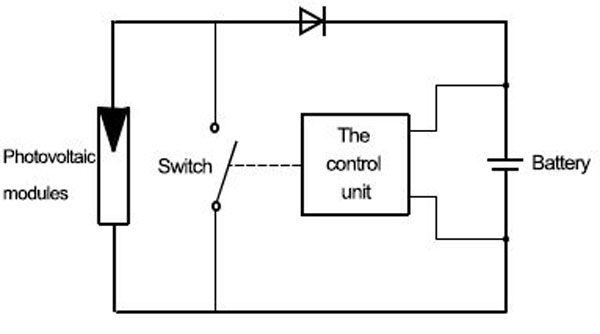
The circuit principle of the parallel charge controller is shown in Fig. The switching elements of the parallel charge controller are connected in parallel at both ends of the PV module, so the power loss of the switching elements in the series charge controller can be solved.
The controller detection circuit monitors the battery terminal voltage, and when the charging voltage exceeds the set full disconnect value (HVD) of the battery, the switching element turns on and bypasses the battery. When the battery terminal voltage drops to the set battery recharge voltage value, the switching element disconnects and turns on the battery charging circuit at the same time. The input circuit of the parallel charge controller is usually connected with a diode, which allows the current to flow to the battery during charging and prevents the battery current from flowing to the PV array at night or during cloudy days. Parallel type charge controller line is simple, cheap, but in the battery is full of protection and photovoltaic modules are still in the power generation state will allow the PV module to produce a large short-circuit current, resulting in "light spot", accelerate aging, the national standard is not recommended.
3. PWM type charge controller
In order to effectively prevent overcharging, the full use of solar energy to charge the battery, in recent years the development of pulse width modulation (PWM) charge controller. PWM charge controller to pulse mode switch PV module input, when the battery tends to be full, with its terminal voltage gradually rise, the frequency of the pulse or duty cycle changes, so that the on time is shortened, the charging current gradually tends to zero. When the battery voltage has a full point of decline, the charging current will gradually increase again. This charging process to form a more complete state of charge, it can increase the total cycle life of the battery annoying people in the photovoltaic system. Pulse width modulation charging protection of the charging state, it can increase the total cycle life of the battery in the photovoltaic system.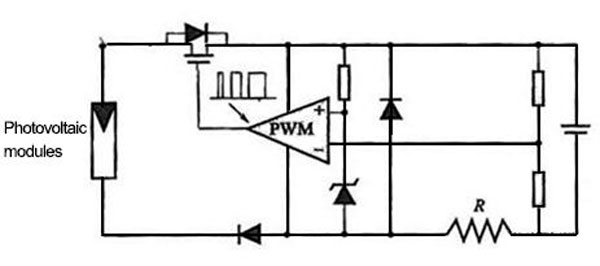
What functions does the solar controller have?
The most basic function of the solar charge controller is to control the battery voltage and turn on the circuit. In addition, it stops charging the battery when the battery voltage rises to a certain level. Older controllers mechanically accomplish the task of controlling the opening or closing of the circuit and stopping or starting the power transfer from the power source to the battery. The detailed functions of the solar controller are shown below:
Load over-current and short-circuit protection
When the load current exceeds 10A or the load is short-circuited, the fuse wire melts and can be used again after replacement.
Over-voltage protection
When the voltage is too high, the output will be automatically turned off to protect the equipment from destruction.
Lightning protection
In the event of a lightning strike, the varistor can prevent the lightning strike and protect the controller from being destroyed.
Battery reversal protection
The battery "+" "-" polarity is reversed, and can be used after correction.
Battery open circuit protection
If the battery is open circuit, if the solar cell is charging normally, the controller will limit the voltage at both ends of the load to ensure that the load is not damaged, if the solar cell is not charging at night or in the case, the controller itself does not get power and will not have any action.
Overcharge protection
When the charging voltage is higher than the protection voltage, the battery will be automatically disconnected from charging, after that when the voltage drops to the holding voltage, the battery will enter into the floating state, and when the floating charge is turned off after the low recovery voltage, it will enter into the even charging state.
Over discharge protection
In the case of low battery voltage over the protection voltage, the controller automatically turns off the output to protect the battery from harm; after the battery is charged again, it can automatically restore power supply.
Self-test function
When the controller suffers from natural factors or personal operation, the controller can be self-tested, so that users know whether the controller is normal, reducing unnecessary man-hours.
Recovery interval: the recovery interval made by the controller overcharge or over discharge protection, to prevent the line resistance or the self-recovery characteristics of the battery from causing the load to work jitter.
Temperature compensation
Monitor the temperature of the battery and make corrections to the charge and discharge values so that the battery works in the ideal state.
Light control
Mostly used in automatic lamps, when the environment is bright enough, the solar controller will automatically turn off the load output; and the surrounding environment will automatically turn on the load when it is dark, in order to achieve the function of automatic control.
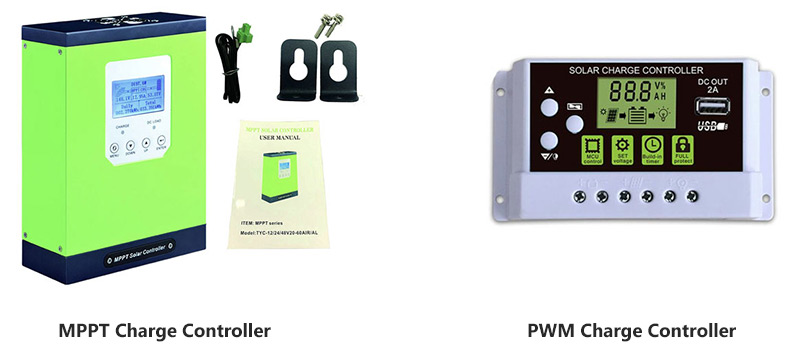
Inverter.com offers you two kinds of solar charge controllers, Maximum Power Point Tracking (MPPT) controllers and Pulse Width Modulation (PWM) controllers. In addition, the all-in-one unit - solar inverter with MPPT charge controller is also available for off-grid solar system. The PWM solar charge controllers have 10 Amp, 20 Amp...60 Amp available with low price and high reliability, suitable for small systems. The MPPT solar charge controllers come with 20A, 30A to 60A with high efficiency and long service life, a best choice to optimize your solar energy. The 700W to 6000W solar inverters with built-in MPPT charge controller perfoms both inverter and charge controller function in one device, a cost-effective solution for off-grid PV system. Find a right one here for utilizing your solar panel.
